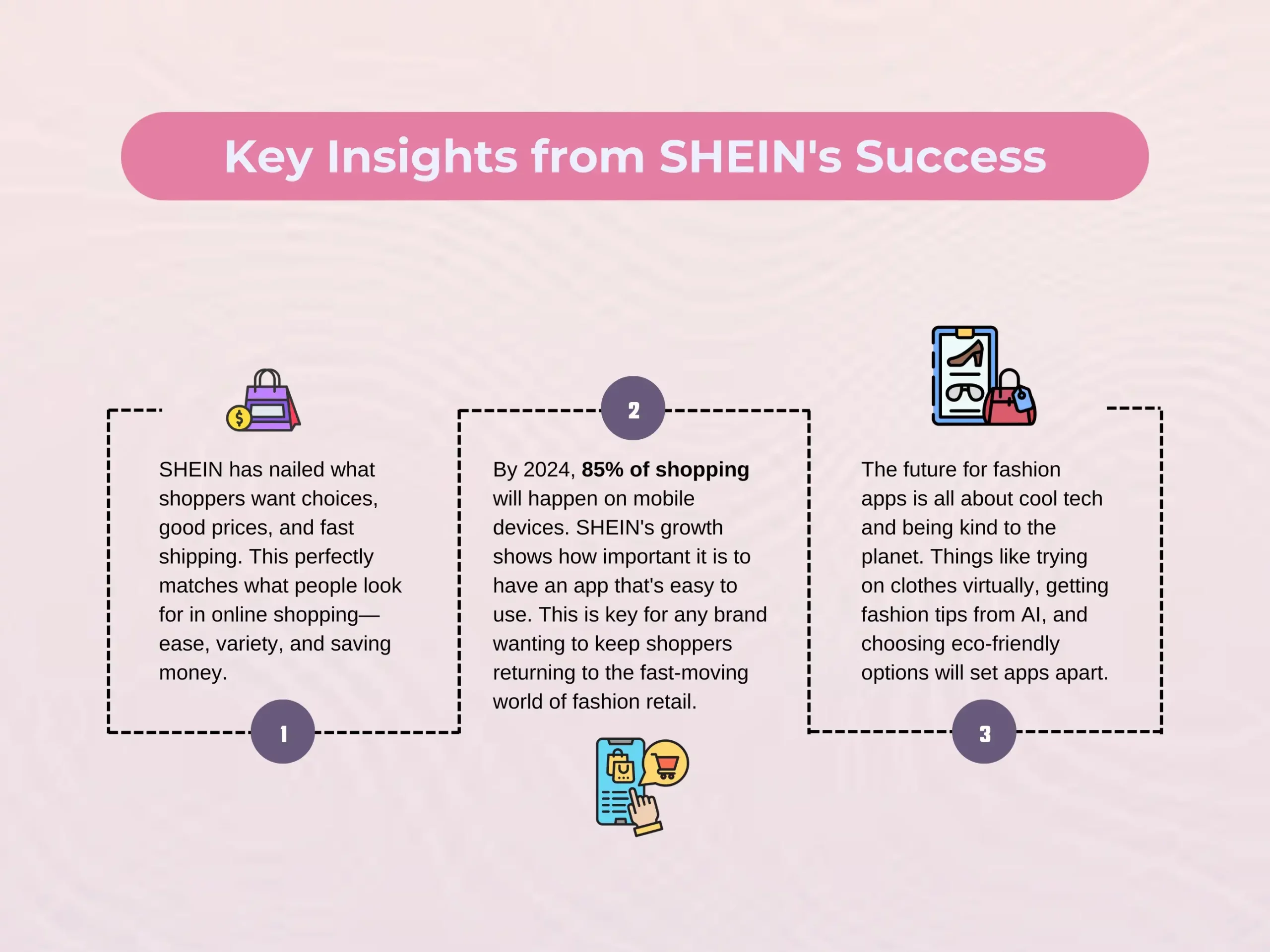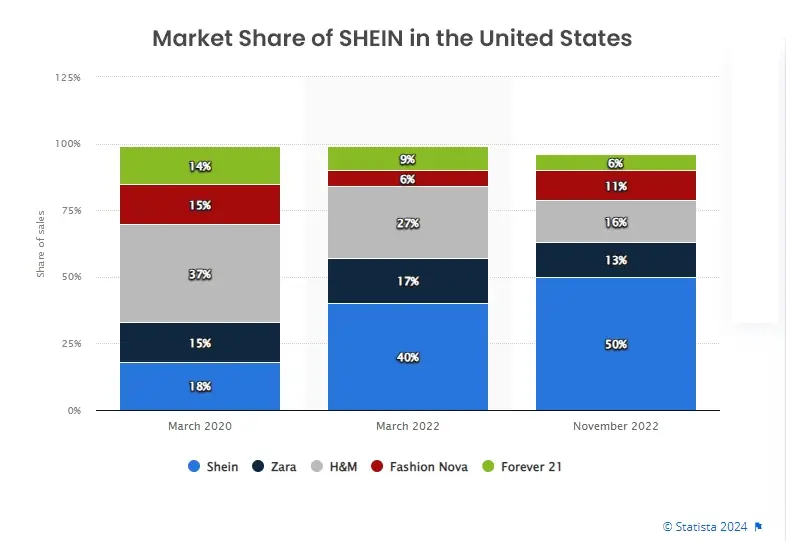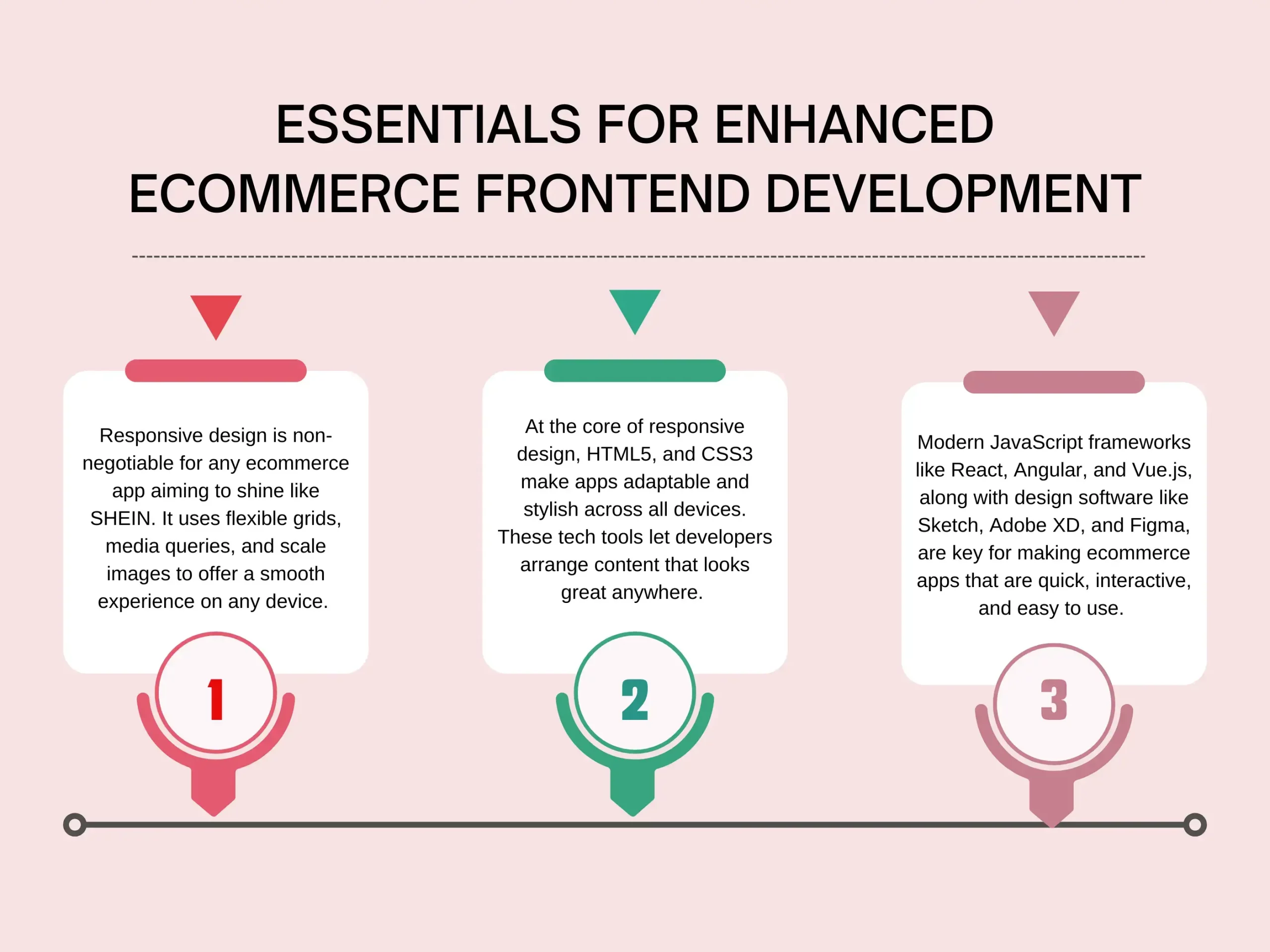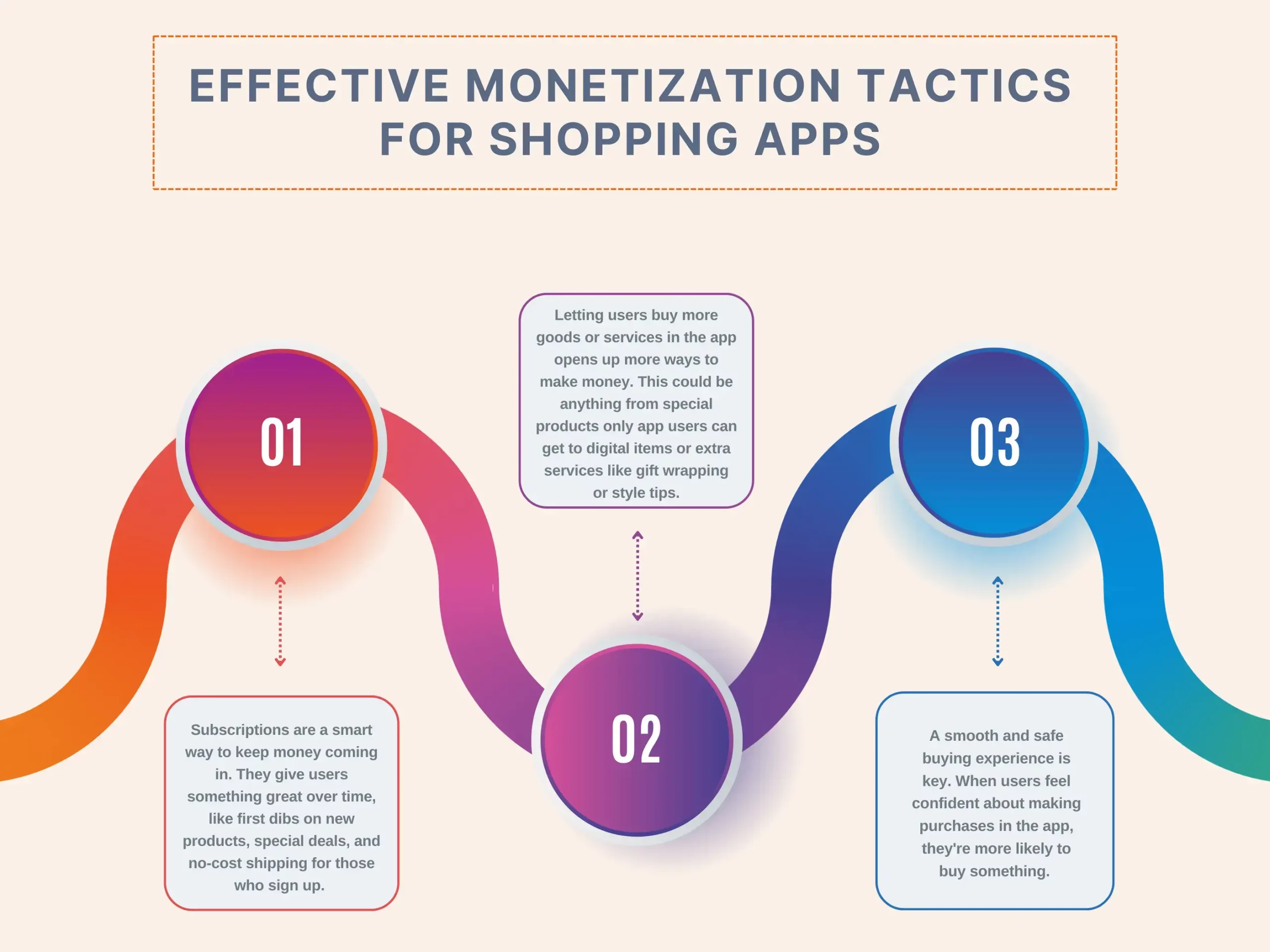Table of Contents
SHEIN stands out because of its wide range of products, good prices, and quick delivery. These factors have helped it attract many users and set new standards for shopping apps. The SHEIN app, in particular, has grown a lot, with more people downloading and using it than ever before.
People want shopping to be easy, have many options, and not spend too much. Apps like SHEIN make this possible. They’re easy to use and offer many fashion choices on your phone. A study says that by 2025, 85% of shopping will be done on phones, making apps more important than ever. More people are also starting to use apps to shop, showing a big opportunity for new apps to enter the market.
If you’re thinking about starting or improving a fashion app, it’s important to know what’s happening in the market and what new technologies are coming. In 2025, we expect to see cool features like trying on clothes virtually, getting fashion tips from AI, and more focus on being eco-friendly. These things can make shopping even better for users and help you keep them interested. Keeping up with these trends helps make sure your app stays competitive. Custom app development services are key here, as they can create something unique that fits your business needs.

Understanding the Market
Launching a fashion app, like those for women’s clothing is more than just having a good idea. It’s about really knowing the market and planning well. Businesses looking to follow in the footsteps of SHEIN, a big name in fast fashion, need to dive deep into market insights. We will look at important steps like figuring out who will use the app and checking out the competition. This is key for any custom mobile application development company that wants to stand out.
Who’s Going to Use Your App?
SHEIN USA app nailed it by targeting young, style-conscious people who love finding good deals on the latest trends. The app is a hit mostly with women aged 18 to 34 who are all about using technology and staying active on social media. These users are the perfect match for clothing apps like SHEIN because they always look for new styles without spending too much.
In the crowded fashion retail market, it’s crucial to understand and divide your market into segments. This way, businesses can tailor their products and market them to fit specific groups. This boosts how satisfied and loyal customers feel. For apps like SHEIN, knowing shoppers’ different needs and likes means they can make shopping feel more personal. Custom mobile application development companies must segment the market to spot niche opportunities, determine customers’ needs, and provide the right solutions.
To be among the top apps in the USA and beyond, you must know what your competitors are doing. SHEIN’s rivals, like Zara, H&M, and ASOS, each have their own way of doing things that make them successful. Zara is about getting new products out fast and using tech in their stores. H&M focuses on being green and working with designers. ASOS offers a wide range of products to appeal to many customers. Understanding these approaches helps spot gaps in the market that new apps can aim to fill.

Key Features of Apps Like SHEIN
User Interface (UI) and User Experience (UX) Design
In mobile apps, especially fashion retail ones like the apps similar to SHEIN, how the app looks and feels—its user interface (UI) and user experience (UX)—is super important. This bit discusses why keeping things simple and looking good matters, with top examples from fashion apps.
UI and UX aren’t just about the app looking pretty. They’re key for keeping users around and happy. Making things simple and visually appealing is a big deal for fashion apps, where pictures and style are everything. A straightforward, easy-to-use interface makes shopping fun, not a headache.
The trick for iOS app development companies and Android experts is blending simplicity with good looks. This balance can make an app like Temu or the next big thing stand out in a sea of apps.
Top Examples in UI/UX for Fashion Apps
A few fashion apps are nailing their UI/UX design, perfect for others to learn from. The SHEIN shopping app uses a straightforward layout with crisp images and little text, letting users scroll through thousands of items without feeling swamped. It’s easy to get around, with clear categories and filters.
Apps like Temu are another example, with its easy-to-use design that makes shopping a breeze. Like SHEIN, it sticks to high-quality images and a simple color palette to keep the spotlight on the products. Its interface is smooth and responsive, helping users find what they need fast, with custom recommendations that make shopping more personal and fun.
Product Catalog Management
Entering today’s fashion app scene means diving into a highly competitive and ever-changing world. For apps like SHEIN, their knack for showcasing a vast and varied product lineup is a big part of their success. This bit talks about the best moves and methods for managing a product catalog well, something every e-commerce app development company needs to nail down to do well.
The heart of a hit women’s clothing app offers many choices—different styles, occasions, and sizes. This variety keeps users coming back to see what’s new. But, managing this mix can be tricky, from keeping track of inventory to making sure product details and images are spot-on.
First up, you need a strong system to manage inventory. This setup must handle many products, keep tabs on what’s available, and update info fast. For apps like SHEIN clothing app, which might list thousands of items, a solid inventory system prevents problems like running out of stock or selling too much, ensuring shoppers have a smooth experience.
Tips for Showcasing Your Catalog
How you show off your product catalog is just as important as managing it. A catalog that looks good can make the shopping experience better, leading to people browsing longer and buying more. Here’s how successful women’s clothing apps do it:
- Personalized Suggestions: Custom ecommerce solutions often use algorithms to recommend products. The app can suggest items they like by looking at what users have checked out or bought. This makes shopping more personal and can help users find new favorites.
- Easy to Get Around: A user-friendly interface is crucial. Advanced search filters (like size, color, and price) and clear categories make it easier for users to find what they want. Simple and effective navigation is essential for apps like SHEIN clothing app, which adds new daily items.
- Interactive Features: Adding interactive options like 360-degree views or AR try-on features can make shopping fun. These tools help shoppers better understand how a product looks and fits, reducing doubts and boosting satisfaction.
Join Forces with A3Logics to Craft an App that Reshapes the Future of Women’s Clothing!
Personalization and AI
Competition among shopping apps like SHEIN is intense in today’s digital marketplace. To stand out, adopting Artificial Intelligence (AI) for personalization is not just beneficial—it’s essential. AI makes shopping experiences engaging and tailored to individual tastes. This piece looks at how AI personalised shopping and the advantages of adding recommendation engines to apps like SHEIN, a tactic at the heart of enterprise mobile app development strategies aiming to craft more intuitive apps.
Using AI for a Custom Shopping Journey
- Understanding User Preferences: AI shines through massive data to get what users like and do. Apps like SHEIN use AI to watch what shoppers browse, search for and buy. This info creates a personal shopping space where every user feels seen and appreciated.
- Personal Product Suggestions: A standout AI use in e-commerce is making personalized product suggestions. By looking at past choices, AI guesses what users might like next. This makes shopping smoother, helping users find items they love easily and boosting sales. Apps that nail this can keep customers coming back by always showing them things that feel handpicked for them.
- Custom Marketing Messages: AI also powers personalized marketing. It tailors ads and deals based on each user’s shopping habits, making marketing feel helpful and not annoying. An enterprise mobile app development company can craft messages that hit the mark, turning promotions into valuable shopping aids.
The Upside of Recommendation Engines
- Boosting User Interest: Recommendation engines push user interest up. People stick around longer when the app shows items that match users’ tastes. This is key in a world of e-commerce options, where grabbing and keeping attention is everything.
- Higher Sales: These engines also lift sales by guiding users to products they’re more likely to buy. This smart selling points users to items they want, making shopping effortless and driving up sales.
- Happier Shoppers: Personal touches from AI and recommendation engines make shopping satisfying. Users love it when apps like SHEIN get their style right, turning shopping from a chore into fun. Happy customers are more likely to shop again and spread the word.
Payment and Security Features
In today’s online shopping world, apps like the SHEIN online shopping app have changed how we buy fashion. Making sure payments are safe and offering different payment methods are super important. Also, keeping customer information private is a big deal for shoppers and the businesses making these apps. This part discusses why making payments safe and flexible is key, especially for top mobile app development companies in the USA that also work on logistics app development, to keep users happy and trust in apps similar to SHEIN.
SHEIN can be a good option if you’re looking for trendy clothes at very low prices and understand the potential downsides. However, if you’re looking for high-quality, sustainable clothing or concerned about ethical production, Shein may not be the best choice. – Sebastien Onutali
- Safe and Many Payment Choices: In the world of apps offering cheap clothing apps like SHEIN, it’s crucial to let users pay their way safely. Whether using credit cards, e-wallets, or even cryptocurrencies, offering many payment options makes shopping easier for everyone.
- Trust Leads to More Sales: Users who feel their money and data are safe are likelier to buy. Building this trust comes from being open about how the app keeps data safe and offering familiar payment options.
- Earning Trust Through Law Compliance: Following these privacy laws shows users that an app cares about their privacy, which is especially important for apps like SHEIN, where customers share a lot of personal and financial information.
- Letting Users Control Their Data: Offering users control over their data, like choosing what to share, makes them feel more secure. This is particularly important for logistics app development, where location and other sensitive information are used.
Elevate your Fashion Tech Journey with A3Logics
Technology Stack for Building Fashion Apps
Choosing the Right Platform
When creating ecommerce apps, especially aiming to stand alongside top women’s clothing apps like SHEIN, picking the right tech path is crucial. This choice greatly affects how accessible, fast, and satisfying the app is. Here, we’ll choose between developing specifically for one operating system (OS) or making one app that works across many.
Native vs. Cross-Platform Development
Going Native
Developing natively means making an app for one OS with its preferred languages and tools—Swift or Objective-C for iOS and Kotlin or Java for Android. Native apps shine in speed and smoothness. They work great because they’re made for that specific phone or tablet, using all its features well. But, making a separate app for each OS can take more time and money.
Cross-Platform Approach
Cross-platform app development lets you write your app once and have it run on both iOS and Android. Tools like Flutter, React Native, and Xamarin make this possible. This can save a lot of development time and money. These apps are getting better at matching the native ones in how fast and functional they are, but there might still be some limits, especially in how slick the app feels or in using certain phone-specific features.
If most of your users are on one type of device, making a native app for that platform could offer the best experience. If your audience is split between device types, or you want to reach as many people as possible, cross-platform might be smarter so no one is left out. This ensures your app meets user needs and stands a strong chance of becoming one of the best women’s clothing apps.
Backend Technologies
Success stories like SHEIN highlight the importance of the right tech behind the scenes in today’s online shopping world. This backbone—how an app handles growth, sorts data, and works with other services—is key. For those in ecommerce app development services, picking scalable tech and strong databases, plus integrating with outside services, is essential for building a top-notch ecommerce platform.
Tech That Grows with You
Scalable Tech
Because ecommerce apps must manage many users and data, their backends must grow smoothly. Cloud computing services like AWS, Google Cloud, or Microsoft Azure let the app scale up or down easily, keeping it fast and reliable. This adaptability is crucial for a great shopping experience, something all leading apps aim for.
Smart Database Choices
A good database system ensures the app can quickly handle and find tons of data, for massive product lists and user info, like SHEIN’s, databases that fetch data fast and update in real-time are vital. NoSQL databases (like MongoDB or Cassandra) handle lots of data without strict structure. SQL databases (like PostgreSQL) are strong choices for their reliable transactions and data accuracy.
Working with Other Services
Adding More Features
Using third-party services and APIs adds cool features without building everything from scratch. Payment systems, social media, and shipment tracking can all be added easily, making the app more useful and fun.
Making Things Run Smoother
Linking the app with external tools can improve the business’s efficiency. Inventory, customer relations, and data analysis tools can give a clear view of how things are going, helping make smart decisions. This network of connected services makes the business agile and ready to keep up with e-commerce’s quick pace.
Frontend Technologies
In ecommerce, how apps present themselves and interact with users is key. This is true for popular shopping apps and crucial for POS software developers aiming to make their mark. This section dives into responsive design and the tech tools that help build captivating user interfaces.

Responsive Design Basics
Today, apps must look and work great on any screen with people using various devices to shop. Responsive design makes sure of this. It adjusts layouts to fit screens of all sizes, keeps text readable without zooming, and ensures buttons are easy to tap. For global audiences like those of shopping apps, responsive design is essential. It boosts user happiness and even helps with Google rankings. Achieving this involves using flexible grids, media queries, and scalable images so the app shines on any device.
Tools for an Engaging User Interface
The tech used in front-end development deeply affects how interesting and interactive the app’s interface will be. POS software developers have many options to enhance ecommerce app interfaces.
HTML5 and CSS3
These are the building blocks of responsive design. They let developers organize content and style it to adapt to any screen. CSS3’s media queries are especially key, allowing apps to adjust styles based on the device’s size.
JavaScript Frameworks
App Programming languages & frameworks like React, Angular, and Vue.js are big in web development, including for ecommerce. They help manage complex interfaces with dynamic content. For example, React’s virtual DOM speeds up changes to the interface, making the app faster and smoother for users.
UI Design Tools
Tools like Sketch, Adobe XD, and Figma help POS software developers and designers prototype and refine designs quickly. They support teamwork, letting everyone give feedback and make improvements before coding starts. This way, the final app isn’t just technically solid, visually appealing, and easy to use.
Marketing and Customer Acquisition Strategies
Making a successful app in the digital marketplace goes beyond top-notch tech and design. For ecommerce and apps similar to SHEIN, smart marketing and getting customers on board are key to growth and a strong customer following. An on demand app development company aiming to reach or beat SHEIN’s success must dive deep into digital marketing, especially on social media, SEO, and content marketing. These are vital for boosting your brand and drawing in potential customers.
Social Media
Social media is a goldmine for connecting with people. It lets brands reach a big audience, targeting specific groups. Adding social media features to an app makes sharing products or experiences easy, helping build a community around the brand. SHEIN’s magic on Instagram, TikTok, and Facebook, showing off fashion through eye-catching posts and influencer partnerships, is a perfect example.
Great social media campaigns mix creative ideas with smart targeting. Take SHEIN’s TikTok hashtag challenges—they get users to make themed content, turning them into brand cheerleaders. Instagram Stories can offer time-limited deals or sneak peeks, making things feel exclusive. These tactics make your brand more visible and boost app visits, downloads, and buys.
SEO and Content
SEO is just as crucial for apps as for websites. It helps your app show up in search results and app stores. For ecommerce apps, this means using the right keywords in your app’s store listing, crafting engaging descriptions, and using online content for better search rankings. An on-demand app development company must see SEO as a vital, long-term play for better visibility and growth.
Content marketing is about drawing and keeping an audience with valuable content. For apps like SHEIN, think fashion blogs, style tips, videos, or showcasing user content. The goal is to offer something that speaks to your audience: tips, fun, or inspiration. Great content builds loyalty and boosts SEO by keeping people on your site longer and helping with keywords.
Integrating social media makes sharing easier and broadens your app’s reach. A strong SEO and content strategy ensures that more people find and love your app and its content, driving natural traffic and interest.
Monetization Strategies
In the bustling world of mobile apps, especially for online shopping like SHEIN, figuring out how to make money is key to keeping the app growing and paying its way. Android app development companies, like those focusing on iOS, always look for smart ways to earn while making the app fun and useful.

Subscriptions
Many apps use subscriptions to get steady money by charging users regularly for extra features or content. This is great for apps that keep giving users something valuable over time, like special shopping deals or rewards. For example, a fashion app could let premium users see new stuff first, get special discounts, or not pay for shipping.
The trick is to keep giving more than what the subscription costs. Android app development companies must consider what to include in the subscription to improve shopping without leaving out users who don’t pay.
In-App Buys
In-app buys let users pay for extra goods or services in the app. This is a natural fit for ecommerce apps where buying things is the main point. But you can also sell digital stuff or extras, like gift wrapping or fashion advice.
Making sure buying is easy and safe in the app encourages users to spend more. Exclusive items or services can also tempt users to buy more.
Challenges and Solutions
Launching a fashion app in today’s market has hurdles. Apps like SHEIN have raised the bar, presenting challenges in user experience and market presence for newcomers. Yet, the best eCommerce development companies have found ways to tackle these challenges head-on. This part discusses the common issues faced when developing and launching a fashion app and offers solutions to these obstacles.
Making the User Experience Smooth
A big challenge is designing apps like Shein that look good and are easy to use. Users expect flawless function and quick performance. Any problem can turn users away.
Solution: Deep dive into UI/UX design. This means knowing what your users like, testing the app’s usability, and improving based on feedback. A mobile-first design makes sure the app works well on phones. Working with skilled designers and developers who know the latest trends can make a big difference in how users see your app.
Standing Out in the Market
With so many fashion apps, grabbing users’ attention is tough. Most apps offer the same things, which makes it hard for new apps to shine.
Solution: Find what makes your app special. This could be exclusive products, personalized shopping, or cool tech like AR try-ons. Market research to spot what’s missing in current apps and fill that gap can give your app an edge. Using social media and influencers can also draw eyes to your app’s unique features.
Growing Without Trouble
When your app starts to take off, ensuring it can handle more users and sales without glitches is challenging.
Solution: Use scalable cloud tech so your app can grow smoothly. Microservices architecture helps manage app parts more easily, letting you scale up needed parts. Teaming up with top eCommerce development companies experienced in scaling can offer the tech and advice needed for growth.
Following the Rules
Keeping up with laws like GDPR in Europe or CCPA in California adds complexity, especially for apps going global.
Solution: Build your app with privacy and legal stuff in mind. This means clear policies on data, safe data handling, and getting user consent. Talking to legal experts in your app’s markets can help ensure you’re doing things right.
Conclusion
Launching a women’s clothing app in today’s fast-paced digital world, aiming for success apps like SHEIN, involves a mix of strategy, tech-savvy, and effective marketing. This conclusion summarizes the crucial steps for creating a thriving fashion app and looks ahead at what’s coming in the fashion app scene.
The outlook for fashion apps is bright, with new tech offering exciting shopping. AI and AR/VR Solutions are changing the game, making shopping more personal and fun with features like style tips just for you and trying on clothes virtually. Also, more shoppers want to know their purchases are ethical and sustainable, so apps that show they care about these issues could get ahead.
As online and in-store shopping blend more, apps that connect the two smoothly—for example, by letting you book in-store try-ons online—will stand out. Social commerce will also be big, using social media and influencers to sell directly.
In short, building a fashion app like SHEIN takes careful planning and hard work but is doable. With the fashion app world constantly evolving, now is an exciting time to start creating an app that could lead the way.
If you’re ready to dive in, use these insights by A3Logics to kick off your project and shape the future of fashion shopping.
Book 30 Minutes Free Consultations with A3Logics Experts to Start Your App Journey Today!
FAQs
What makes apps like SHEIN stand out?
SHEIN’s magic comes from its easy-to-use design, a vast selection of affordable clothes, personalized shopping experiences, and smooth shipping. Features like AI recommendations, high-quality photos, and clear product details keep users returning. Constantly adding new items keeps the app fresh and exciting.
What marketing strategies work best for a new women’s clothing app?
Great ways to get the word out about your new app include using social media, working with influencers, ensuring your app shows up in search engines (SEO), and creating interesting content. Social media lets you show off your products and talk to customers directly. Influencers can introduce your app to more people. SEO and good content help people find your app online.
How does AI make shopping better in fashion apps?
Artificial Intelligence Development can make shopping more personal by suggesting products that fit what each user likes. It lets users try on clothes virtually with their phone’s camera. AI chatbots can answer questions and help with shopping, making the whole experience more one-on-one.
How can smaller shops compete with big apps like SHEIN?
Small businesses can find their own space by focusing on special products, giving amazing customer service, and creating a shopping experience that feels personal. Using social media to connect with customers and quickly adapt to their wants can help a lot.
What tech trends should app makers watch for in 2025?
Keep an eye on tech like AR for trying things virtually, AI for suggestions just for you, and blockchain development for safe shopping. Shopping directly through social media is getting more popular, too. More and more, shoppers care about buying from brands that are kind and good for the planet, so apps that show how products are made and where they come from could do well.






